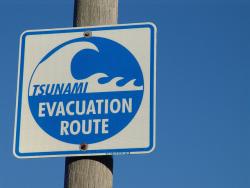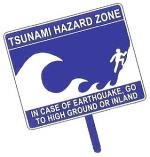Tsunami Information
This information could save your life! Please read it and share it with your family and friends.
Plan ahead! Download the Bandon Tsunami Evacuation Route Map
IF YOU FEEL AN EARTHQUAKE, a tsunami may be coming...
What To Do
 1. Drop, Cover, Hold until the earthquake is over, protect yourself
1. Drop, Cover, Hold until the earthquake is over, protect yourself
2. Move immediately inland to high ground and away from low-lying coastal areas.
3. Follow Evacuation Route signs (image right)
4. Do not wait for an official warning
5. Go on foot if at all possible
6. Do not pack or delay
7. Do not return to the beach - large waves may continue to come onshore for several hours
8. Wait for an "ALL CLEAR" from local emergency officials before returning to low-lying areas
WHAT TO KNOW about tsunamis
A tsunami is a series of sea waves, usually caused by a displacement of the ocean floor by an undersea earthquake. As tsunamis enter shallow water near land, they increase in height and cause great loss of life and property damage.
Recent research suggests that tsunamis have struck the Oregon coast on a regular basis. They can occur at any time, day or night. Typical wave heights from tsunamis occurring in the Pacific Ocean over the last 500 years have been 20-65 feet at the shoreline. However, because of local conditions a few waves may have been much higher - as much as 100 feet.
We distinguish between a tsunami caused by undersea earthquakes near the Oregon coast (a local tsunami) and an undersea earthquake far away from the coast (a distant tsunami).
Local Tsunamis
A local tsunami can come onshore within 15 to 20 minutes after the earthquake - before there is time for an official warning from the national warning system. Ground shaking from the earthquake may be the only warning you have. Evacuate quickly!
Distant Tsunamis
A distant tsunami will take 4 hours or more to come ashore. You will feel no earthquake, and the tsunami will generally be smaller than that from a local earthquake. Typically, there is time for an official warning and evacuation to safety.
Evacuation for a distant tsunami will generally be indicated by a 3-minute siren blast (if your area has sirens) and an announcement over NOAA weather radio that the local area has been put into an official TSUNAMI WARNING. In isolated areas along beaches and bays you may not hear a warning siren. Here, a sudden change of sea level should prompt you to move immediately to high ground. If you hear the 3-minute blast or see a sudden sea level change, first evacuate away from shoreline areas, then turn on your local broadcast media or NOAA weather radio for more information.
WHAT TO DO for both local and distant tsunamis
 1. Evacuate on foot, if at all possible. Look for the Tsunami Hazard Zone signs (image right) and leave the area by following Evacuation Route signs and arrows.
1. Evacuate on foot, if at all possible. Look for the Tsunami Hazard Zone signs (image right) and leave the area by following Evacuation Route signs and arrows.
2. If you need help evacuation, tie something white (sheet or towel) to the front door knob. Make it large enough to be visible from the street. If the emergency is a distant tsunami, then help may arrive. In the event of a local tsunami, it is unlikely that anyone will help you, so make a plan and be prepared!
3. Stay away from potentially hazardous areas until you receive an ALL CLEAR from local officials. Tsunamis often follow river channels, and dangerous waves can persist for several hours. Local officials must inspect all flooded or earthquake-damaged structures before anyone can go back into them.
4. After evacuation, check with local emergency officials if you think you have special skills and can help, or if you need assistance locating lost family members.
BE PREPARED!
Assemble emergency kits with at least a 3-day supply for each family member:
- Local map showing safe evacuation routes to high ground.
- First-aid supplies, prescriptions and non-prescription medications.
- Water bottle and filtration or treatment supplies capable of providing 1 gallon per person, per day.
- Non-perishable food (ready-to-eat meals, canned food, baby food, energy bars).
- Cooking and eating utensils, can opener, Sterno or other heat source.
- Matches in water-proof container or lighter.
- Shelter (tent), sleeping bags, blankets.
- Portable radio, NOAA weather radio, flashlight, and extra batteries.
- Rain gear, sturdy footwear, extra clothing.
- Personal hygiene items (toilet paper, soap, toothbrush).
- Tools and supplies (pocket knife, shut-off wrench, duct tape, gloves, whistles, plastic bags.
- Cash.
How to help with tsunami awareness in your community
- Start a tsunami buddy system
- Make and distribute emergency packs
- Initiate or participate in a local preparedness program
CONTACTS
Oregon Emergency Management
3225 State Street, P.O. Box 14370
Salem, OR 97309
503-378-2911
http://www.oregon.gov/OMD/OEM
Bandon Police Department
555 Highway 101
Bandon, OR 97411
541-347-2241 or 800-924-8996
http://www.cityofbandon.org/police
Oregon Department of Geology and Mineral Industries
800 NE Oregon Street #28, Suite 965
Portland, OR 97232
971-673-1555
http://www.oregongeology.org
http://www.oregontsunami.org
Nature of the Northwest Information Center
800 NE Oregon Street #28, Suite 965
Portland, OR 97232
971-673-2331
International Tsunami Information Center
Box 50027
Honolulu, HI 96850-4993
808-541-1658
http://www.tsunamiwave.info
